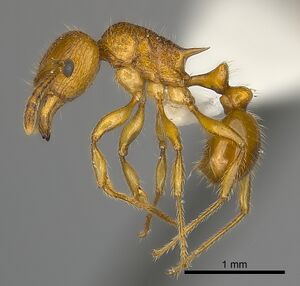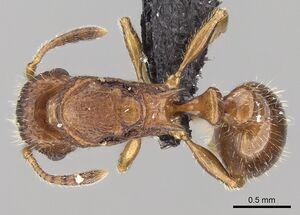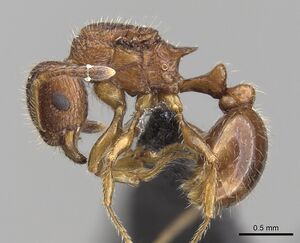Tetramorium vony
| Tetramorium vony | |
|---|---|

| |
| Scientific classification | |
| Kingdom: | Animalia |
| Phylum: | Arthropoda |
| Class: | Insecta |
| Order: | Hymenoptera |
| Family: | Formicidae |
| Subfamily: | Myrmicinae |
| Tribe: | Crematogastrini |
| Genus: | Tetramorium |
| Species: | T. vony |
| Binomial name | |
| Tetramorium vony Hita Garcia & Fisher, 2012 | |
T. vony is mainly found in tropical dry forests and only very rarely in tropical rainforests. Also, it has an altitudinal range from 60 to 1025 m, but appears to prefer lower elevations. (Hita Garcia and Fisher 2012)
Identification
A member of the Tetramorium bonibony-species group
Tetramorium vony can be clearly distinguished within the T. bonibony group by the following character combination: mesosoma with well developed anterior face of pronotum but without anterodorsal median protuberance; petiolar node in profile triangular cuneiform, dorsally strongly anteroposteriorly compressed, and highly transverse in dorsal view (LPeI 31 - 41; DPeI 245 - 333); postpetiole as wide as to weakly wider than petiolar node (PPI 100 - 107); body of uniform yellow colour. (Hita Garcia and Fisher 2012)
Keys including this Species
Distribution
The distribution of T. vony is mainly restricted to the north of Madagascar. There it occurs from Andavakoera, Antsahabe, and Bekaraoka north to Montagne des Français. However, a single specimen from the botanical garden at the Andasibe National Park was confidently identified as T. vony, although no other conspecific material is known between Andasibe and the northern localities mentioned above. Since T. vony was predominantly sampled from lower vegetation, it is possible that the specimen from the botanical garden was transported with plant material from the main distribution of the species in the north. (Hita Garcia and Fisher 2012)
Latitudinal Distribution Pattern
Latitudinal Range: -12.32278° to -18.92639°.
| North Temperate |
North Subtropical |
Tropical | South Subtropical |
South Temperate |
- Source: AntMaps
Distribution based on Regional Taxon Lists
Malagasy Region: Madagascar (type locality).
Distribution based on AntMaps
Distribution based on AntWeb specimens
Check data from AntWeb
Countries Occupied
| Number of countries occupied by this species based on AntWiki Regional Taxon Lists. In general, fewer countries occupied indicates a narrower range, while more countries indicates a more widespread species. |

|
Estimated Abundance
| Relative abundance based on number of AntMaps records per species (this species within the purple bar). Fewer records (to the left) indicates a less abundant/encountered species while more records (to the right) indicates more abundant/encountered species. |

|
Biology
Castes
Images from AntWeb
   
| |
| Holotype of Tetramorium vony. Worker. Specimen code casent0404272. Photographer Will Ericson, uploaded by California Academy of Sciences. | Owned by CAS, San Francisco, CA, USA. |
   
| |
| Paratype of Tetramorium vony. Worker. Specimen code casent0404286. Photographer Estella Ortega, uploaded by California Academy of Sciences. | Owned by CAS, San Francisco, CA, USA. |
   
| |
| Paratype of unpublished name: Tetramorium incertum. Worker. Specimen code casent0404310. Photographer Ryan Perry, uploaded by California Academy of Sciences. | Owned by NHMUK, London, UK. |
   
| |
| Worker. Specimen code casent0443714. Photographer Shannon Hartman, uploaded by California Academy of Sciences. | Owned by CAS, San Francisco, CA, USA. |
    
| |
| Worker. Specimen code casent0498388. Photographer Erin Prado, uploaded by California Academy of Sciences. | Owned by CAS, San Francisco, CA, USA. |
Nomenclature
The following information is derived from Barry Bolton's Online Catalogue of the Ants of the World.
- vony. Tetramorium vony Hita Garcia & Fisher, 2012: 52, figs. 40, 42, 44, 66-68 (w.) MADAGASCAR.
Unless otherwise noted the text for the remainder of this section is reported from the publication that includes the original description.
Description
Worker
HL 0.67 - 0.80 (0.73); HW 0.65 - 0.79 (0.72); SL 0.46 - 0.56 (0.50); EL 0.14 - 0.18 (0.16); PH 0.41 - 0.48 (0.44); PW 0.49 - 0.61 (0.54); WL 0.85 - 0.98 (0.92); PSL 0.23 - 0.33 (0.28); PTL 0.09 - 0.11 (0.10); PTH 0.27 - 0.33 (0.30); PTW 0.27 - 0.34 (0.30); PPL 0.21 - 0.25 (0.22); PPH 0.28 - 0.35 (0.31); PPW 0.28 - 0.34 (0.31); CI 96 - 99 (98); SI 68 - 72 (70); OI 22 - 24 (22); DMI 56 - 62 (58); LMI 46 - 49 (48); PSLI 33 - 42 (38); PeNI 53 - 59 (56); LPeI 31 - 41 (34); DPeI 245 - 333 (298); PpNI 55 - 59 (57); LPpI 69 - 77 (72); DPpI 133 - 143 (138); PPI 100 - 107 (102) (12 measured).
Head usually slightly longer than wide (CI 96 - 99). Anterior clypeal margin with median impression. Frontal carinae weakly to moderately developed, fading out between posterior eye margin and posterior head margin. Antennal scrobes absent. Antennal scapes short, not reaching posterior head margin (SI 68 - 72). Eyes of moderate size (OI 22 - 24). Mesosoma with well developed anterior face of pronotum, but without any anterodorsal median protuberance, mesosoma weakly marginate from lateral to dorsal mesosoma; promesonotal suture and metanotal groove absent, mesosoma comparatively high, compact, and stout (LMI 46 - 49). Propodeal spines long to very long, spinose, and acute (PSLI 33 - 42); propodeal lobes small and triangular. Petiolar node in profile triangular cuneiform, strongly anteroposteriorly compressed dorsally, approximately 2.4 to 3.3 times higher than long (LPeI 31 - 41), anterior and posterior faces not parallel; node in dorsal view highly transverse, between 2.4 to 3.3 times wider than long (DPeI 245 - 333). Postpetiole in profile approximately rounded and weakly anteroposteriorly compressed, approximately 1.3 to 1.5 times higher than long (LPpI 69 - 77), in dorsal view between 1.3 to 1.5 times wider than long (DPpI 133 - 143). Postpetiole in profile appearing slightly more voluminous than petiolar node, in dorsal view approximately as wide as to weakly wider than petiolar node (PPI 100 - 107). Mandibles striate; clypeus with one distinct median longitudinal ruga and one or two often weaker rugae at each side; cephalic dorsum between frontal carinae anteriorly and centrally longitudinally rugose and posteriorly reticulate-rugose, dorsum with five to nine longitudinal rugae, rugae ending close to posterior head margin but often broken or with cross-meshes, always with one well-developed longitudinal median ruga, median ruga running from posterior head margin to posterior clypeal margin, approximately at eye level diverging into two rugae leading to posterior clypeal margin; lateral and ventral head mainly reticulate-rugose to longitudinally rugose. Ground sculpture on head weakly to moderately reticulate-punctate. Mesosoma laterally reticulate-rugose to irregularly longitudinally rugose, anteriorly often weakly sculptured; dorsal mesosoma mainly reticulate-rugose. Waist segments and gaster unsculptured, smooth, and shiny. All dorsal surfaces of body with abundant, moderately long, fine, and erect pilosity. Body of uniform yellow to light brown colour.
Type Material
Holotype worker, MADAGASCAR, Antsiranana, Réserve Spéciale de l'Ankarana, 13.6 km 192° SSW Anivorano Nord, 12.8636 S, 49.2258 E, 210 m, tropical dry forest, beating low vegetation, collection code BLF03016, 16.-21.II.2001 (B.L. Fisher, C. Griswold et al.) (California Academy of Sciences: CASENT0404272). Paratypes, 43 workers with same data as holotype (The Natural History Museum: CASENT0404282; CASENT0404310; CASC: CASENT0404270; CASENT0404271; CASENT0404275; CASENT0404276; CASENT0404279; CASENT0404280; CASENT0404281; CASENT0404286; CASENT0404287; CASENT0404288; CASENT0404290; CASENT0404291; CASENT0404292; CASENT0404293; CASENT0404297; CASENT0404298; CASENT0404299; CASENT0404301; CASENT0404304; CASENT0404305; CASENT0404306; CASENT0404308; CASENT0404309; CASENT0404311; CASENT0404312; CASENT0404320; CASENT0404321; CASENT0404332; Musee d'Histoire Naturelle Genève: CASENT0404277; Museum of Comparative Zoology: CASENT0404278; Naturhistorisches Museum, Basel: CASENT0404289).
Etymology
The name of the new species is Malagasy and means "yellow". The epithet is treated as a noun in apposition, and thus invariant.
References
References based on Global Ant Biodiversity Informatics
- Garcia H. F. and B. L. Fisher. 2012. The ant genus Tetramorium Mayr (Hymenoptera: Formicidae) in the Malagasy regiontaxonomy of the T. bessonii, T. bonibony, T. dysalum, T. marginatum, T. tsingy, and T. weitzeckeri species groups. Zootaxa 3365: 1-123

